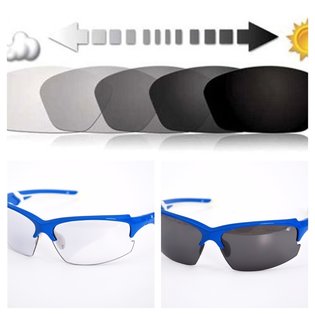
There are many mtb glasses options available for basic protection but if you want glasses that will work all day in all weather conditions you should buy a pair with photochromic lenses.
What are photochromic lenses
The word "photochromic" comes from two Greek words "photos" meaning light and "Chroma" meaning colour—so photochromic simply means something that changes colour in response to light. In relation to sunglasses, photochromic lenses darken or lighten dependent on their exposure to ultraviolet (UV) radiation. For example, once the UV is removed by walking indoors or reduced by cycling through trees, the lenses will gradually return to their clear state or a lighter tint respectively.
Photochromic lenses were originally developed in the 1960’s and made from glass. They worked a bit like pieces of old-fashioned, photographic film. Film darkens because it contains silver based chemicals that clump together when light falls on them. Early photochromic lenses contained similar silver chemicals and darkened the same way. Unlike photographic film, which darkens permanently, the photochromic lenses could change back again and clear when the light level fell back to normal.
Modern sports photochromic lenses are now made of poly-carbonate(PC) which offers excellent impact protection and optical clarity. The photochromic activity is due to organic (carbon-based) molecules that are embedded into the surface to a uniform thickness of 150 µm on the inside of the lens providing an even shade of tint when the lenses darken. Although each molecule changes by only a fraction of a nanometre, when many molecules respond in the same way the effect can be dramatic as more and more light is progressively blocked out.
Today's photochromic lenses can offer different categories of sun protection to meet specific needs. For example, you can buy lenses that will start clear and go dark grey suitable for day and night riding. There are others that will start as tinted and become progressively darker. These are ideal as sunglasses and brighter environments, beaches and skiing. In addition there are now lenses which have a different base colour such as grey or orange. Grey tints have a neutral impact on the image perception whereas orange tints can reduce blue light and can improve contrast with green and reds. Rad8 Photochromic lenses typically have a light absorption range from 15% to 74% and currently use the grey/neutral lenses
PC Photochromic lenses typically take around 30 seconds to fully darken and approx 2 - 5 minutes to return to a clear state. Initial changes occur quite rapidly and your eyes will naturally compensate for the light changes as the lenses adjust.
What are photochromic lenses
The word "photochromic" comes from two Greek words "photos" meaning light and "Chroma" meaning colour—so photochromic simply means something that changes colour in response to light. In relation to sunglasses, photochromic lenses darken or lighten dependent on their exposure to ultraviolet (UV) radiation. For example, once the UV is removed by walking indoors or reduced by cycling through trees, the lenses will gradually return to their clear state or a lighter tint respectively.
Photochromic lenses were originally developed in the 1960’s and made from glass. They worked a bit like pieces of old-fashioned, photographic film. Film darkens because it contains silver based chemicals that clump together when light falls on them. Early photochromic lenses contained similar silver chemicals and darkened the same way. Unlike photographic film, which darkens permanently, the photochromic lenses could change back again and clear when the light level fell back to normal.
Modern sports photochromic lenses are now made of poly-carbonate(PC) which offers excellent impact protection and optical clarity. The photochromic activity is due to organic (carbon-based) molecules that are embedded into the surface to a uniform thickness of 150 µm on the inside of the lens providing an even shade of tint when the lenses darken. Although each molecule changes by only a fraction of a nanometre, when many molecules respond in the same way the effect can be dramatic as more and more light is progressively blocked out.
Today's photochromic lenses can offer different categories of sun protection to meet specific needs. For example, you can buy lenses that will start clear and go dark grey suitable for day and night riding. There are others that will start as tinted and become progressively darker. These are ideal as sunglasses and brighter environments, beaches and skiing. In addition there are now lenses which have a different base colour such as grey or orange. Grey tints have a neutral impact on the image perception whereas orange tints can reduce blue light and can improve contrast with green and reds. Rad8 Photochromic lenses typically have a light absorption range from 15% to 74% and currently use the grey/neutral lenses
PC Photochromic lenses typically take around 30 seconds to fully darken and approx 2 - 5 minutes to return to a clear state. Initial changes occur quite rapidly and your eyes will naturally compensate for the light changes as the lenses adjust.
|
|
|

So why not wear the standard mtb options out there;
Clear lenses. As the name would suggest clear lenses offer the simple solution and provide good clarity and basic protection. They can be good for night riding and in winter months. In general, however, low cost clear glasses do not have the same optical clarity or coatings ( anti-fog/ anti-scratch) as more expensive options.
Fixed tint lenses, these are available in the vast majority of glasses, they can be multi-coloured, red, blue and every colour option in between. Certain lens colours are believed to improve image perception. For overcast flat light days, with an over-abundance of blue light, yellow or rose tints may be used. Grey tints reduce transmittance across the spectrum. Polarised lenses may also be used, but these tend to mask small contours on the slope. Visible and UV transmittance may also be further reduced by the use of mirror coatings. Generally fixed tint lenses are category 3. This means that between 80 and 92% of the visible light is absorbed. As a consequence, in dull light conditions your eyes will need to work very hard to get enough light in to allow good vision. Most riders will subconsciously remove tinted glasses when entering wooded areas.
Interchangeable lenses Some glasses designs are available with removable lenses allowing users to fit different lenses according to the weather conditions. This option is generally fixed tint, polarised or clear and can be a great solution if you know what the riding conditions are going to be for your day out.
LED Lenses- New technology that change the lens contrast at the touch of a button. New Technology great idea but currently very expensive.
Clear lenses. As the name would suggest clear lenses offer the simple solution and provide good clarity and basic protection. They can be good for night riding and in winter months. In general, however, low cost clear glasses do not have the same optical clarity or coatings ( anti-fog/ anti-scratch) as more expensive options.
Fixed tint lenses, these are available in the vast majority of glasses, they can be multi-coloured, red, blue and every colour option in between. Certain lens colours are believed to improve image perception. For overcast flat light days, with an over-abundance of blue light, yellow or rose tints may be used. Grey tints reduce transmittance across the spectrum. Polarised lenses may also be used, but these tend to mask small contours on the slope. Visible and UV transmittance may also be further reduced by the use of mirror coatings. Generally fixed tint lenses are category 3. This means that between 80 and 92% of the visible light is absorbed. As a consequence, in dull light conditions your eyes will need to work very hard to get enough light in to allow good vision. Most riders will subconsciously remove tinted glasses when entering wooded areas.
Interchangeable lenses Some glasses designs are available with removable lenses allowing users to fit different lenses according to the weather conditions. This option is generally fixed tint, polarised or clear and can be a great solution if you know what the riding conditions are going to be for your day out.
LED Lenses- New technology that change the lens contrast at the touch of a button. New Technology great idea but currently very expensive.
|
|
So!
Life always has compromises. Photochromic lenses will work with your eyes to provide a clear view of the trails irrespective of the weather and light conditions so why compromise your vision? Rad8Mtbglasses- trail tested glasses cycling glasses More information Association of British Dispensing Opticians - Website www.abdo.org.uk |

 RSS Feed
RSS Feed
